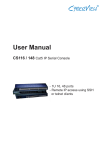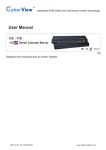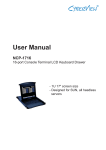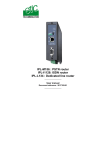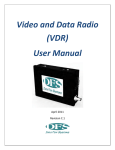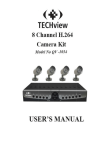Download User Manual
Transcript
Toll Free: 1-888-865-6888 Tel: 510-226-8368 Fax: 510-226-8968 Email: [email protected] KVM User Manual SCK1001 IP Serial Console Server - 1U IP 16-port Serial Console Server Contents Getting Started 1.1 1.2 1.3 1.4 Part 1 Important Safeguards...........................................................................1 Regulatory Notice.................................................................................2 Before Installation.................................................................................3 Unpacking............................................................................................3 SCK1001 Connection 2.1 2.2 2.3 2.4 2.5 2.6 Package Contents................................................................................4 Installation...........................................................................................5 Optional Accessories...........................................................................6 Connection Diagram............................................................................7 Membrane...........................................................................................8 Device Setup...................................................................................9-11 IP Setting 2.7 2.8 2.9 IP Configuration.................................................................................12 IP Filtering....................................................................................13-14 Web Server Configuration............................................................14-16 Serial Port Configuration 2.10 Serial Port Configuration...............................................................17-22 2.11 Connection...................................................................................22-23 2.12 Serial-to-Serial Function...............................................................24-25 System Status & Log ...................................................26 System Setting 2.13 System Administration..................................................................27-28 2.14 Date and Time...................................................................................29 2.15 Fireware Upgrade.........................................................................30-31 Specifications 2.16 Cat5 IP Serial Console Specifications...............................................32 2.17 Connector Pin Assignment.................................................................33 2.18 Appendix A........................................................................................34 1.1 Important Safeguards Please read all of these instructions carefully before you use the device. Save this manual for future reference. What the warranty does not cover ■ ■ Any product, on which the serial number has been defaced, modified or removed. Damage, deterioration or malfunction resulting from: □ □ □ □ □ □ □ □ ■ Accident, misuse, neglect, fire, water, lightning, or other acts of nature, unauthorized product modification, or failure to follow instructions supplied with the product. Repair or attempted repair by anyone not authorized by us. Any damage of the product due to shipment. Removal or installation of the product. Causes external to the product, such as electric power fluctuation or failure. Use of supplies or parts not meeting our specifications. Normal wear and tear. Any other causes which does not relate to a product defect. Removal, installation, and set-up service charges. P.1 1.2 Regulatory Notice Legal Information First English printing, October 2002 Information in this document has been carefully checked for accuracy; however, no guarantee is given to the correctness of the contents. The information in this document is subject to change without notice. We are not liable for any injury or loss that results from the use of this equipment. Safety Instructions ■ ■ Unplug equipment before cleaning. Don’t use liquid or spray detergent; use a moist cloth. Keep equipment away from excessive humidity and heat. Preferably, keep it in an air-conditioned environment with temperatures not exceeding 40º Celsius (104º Fahrenheit). ■ When installing, place the equipment on a sturdy, level surface to prevent it from accidentally falling and causing damage to other equipment or injury to persons nearby. ■ When the drawer is in an open position, do not cover, block or in any way obstruct the gap between it and the power supply. Proper air convection is necessary to keep it from overheating. ■ ■ Arrange the equipment’s power cord in such a way that others won’t trip or fall over it. If you are using a power cord that didn’t ship with the equipment, ensure that it is rated for the voltage and current labeled on the equipment’s electrical ratings label. The voltage rating on the cord should be higher than the one listed on the equipment’s ratings label. ■ ■ Observe all precautions and warnings attached to the equipment. If you don’t intend on using the equipment for a long time, disconnect it from the power outlet to prevent being damaged by transient over-voltage. ■ Keep all liquids away from the equipment to minimize the risk of accidental spillage. Liquid spilled on to the power supply or on other hardware may cause damage, fire or electrical shock. ■ Only qualified service personnel should open the chassis. Opening it yourself could damage the equipment and invalidate its warranty. ■ If any part of the equipment becomes damaged or stops functioning, have it checked by qualified service personnel. Regulatory Notices Federal Communications Commission (FCC) This equipment has been tested and found to comply with the limits for a Class B digital device, pursuant to Part 15 of the FCC rules. These limits are designed to provide reasonable protection against harmful interference in a residential installation. Any changes or modifications made to this equipment may void the user’s authority to operate this equipment. This equipment generates, uses, and can radiate radio frequency energy and, if not installed and used in accordance with the instructions, may cause harmful interference to radio communications. However, there is no guarantee that interference will not occur in a particular installation. If this equipment does cause harmful interference to radio or television reception, which can be determined by turning the equipment off and on, the user is encouraged to try to correct the interference by one or more of the following measures: ■ ■ ■ Re-position or relocate the receiving antenna. Increase the separation between the equipment and receiver. Connect the equipment into an outlet on a circuit different from that to which the receiver is connected. P.2 1.3 Before Installation ■ ■ ■ The surface for placing and fixing the KVM should be stable and level or mounted into a suitable cabinet. ■ Position LCD Keyboard Drawer with respect to related facilities. It is very important to locate the KVM in a suitable environment. Make sure the place has good ventilation, is out of direct sunlight, away from sources of excessive dust, dirt, heat, water, moisture and vibration. 1.4 Unpacking The package comes with the standard parts shown in chapter 2.1 ,3.1 & 4.1 . Check and make sure they are included and in good condition. If anything is missing, or damage, contact the supplier immediately. P.3 2.1 Package Contents 1 6 7 al User Manu 2 3 8 4 5 9 1 Cat5 IP serial console x 1 pc 2 RJ45-DB9 female adapter x 1 pc 3 RJ45-DB9 male adapter x 1 pc 4 Screw M3.2 x 4.5mm x 4 pcs 5 Screw M4 x 10mm x 8 pcs 6 User manual x 1 pc 7 CD disc x 1 pc 8 Power cord x 1 pc 9 Bracket x 1 set P.4 2.2 Installation screw A: M3.2 x 4.5 mm A B Cy r be Vie w screw B: M4 x 10 mm ■ Install each bracket using screws provided shown in Figure 1. ■ Fix the Cat5 IP serial console into the rack. Figure 1. Installing the rear L-bracket to the Cat5 IP serial console. Cy r be Vie w * Hardware for fixing the mounting bracket to the rack is not provided Figure 2. Fixing the Cat5 IP serial console into the rack. P.5 2.3 Optional Accessories 1. RJ45-DB9 adapter 1.1 RJ45-DB9 female adapter 1.2 RJ45-DB9 male adapter 2. Cat5 Cable 2.1 3 feet Cat5 cable 2.2 6 feet Cat5 cable 2.3 10 feet Cat5 cable 2.4 15 feet Cat5 cable 2.5 33 feet Cat5 cable 2.6 66 feet Cat5 cable 3. Power Cord 3.1 IEC power cord 3.2 NEMA 5-15 power cord (US) 3.3 BS 1363 power cord (UK) 3.4 CEE 7/4 power cord (German) 3.5 AS 3112 power cord (Australia) P.6 2.4 Connection Diagram Connection SCK1001 Ethernet Console Serial port Connection Cat5 IP Serial Console RJ45-DB9 female adapter Cat5 cable Computer with RS-232 serial port Cat5 cable Cat5 cable Internet Hub for remote access RJ45-DB9 male adapter Cat5 cable RJ45-DB9 female adapter Hub Router Switch PDU UPS Power module Serially managed device P.7 Headless servers 2.5 Membrane Power ON ■ Turn off all devices / servers and Cat5 IP serial console ■ Make sure all cables / connectors are properly connected Front Panel - Port LED Indications 16 ports Port activity Status LEDs Reset button Power Red: Power on indication Link Orange: 10BaseT Etherent connection Green: 100BaseT Ethernet connection Ready Green: Blinking per second when system is busy Port LED Green: Traffic activity Reset button Press reset button to reboot the unit Warning : Press “Shift+Esc” sets default, it will change the pre-set operating parameters and local access “Personality” P.8 2.6 Device Setup 2.6.1 Setup the IP address from Console Port The IP serial console offers user-friendly menu-driven user interface. User can simply connect a VT-100 terminal to the console port to access to the unit. This is useful when you does not know the network settings of the server, and can not access to the server. In this case, you can view or change the settings (IP address, Subnet mask, etc) via the console port. Please follow the steps below: 1. Connect the console port on the rear panel to a serial port on a PC host using the CAT5 cable and the appropriate RJ45/DB9F adapter packaged with the IPCS unit 2. 3. Configure a terminal emulation program, such as HyperTerminal, using the following settings: ■ Baudrate = 115200, Data bits = 8, Stop bits = 1, Parity = none, Flow control = none Enter the user name and password in order to access to the system. User Name Default Password root root The following figure depicts the structure of the interface. Network > IP Config: The following shows the IP configuration items. 1. 2. For IP mode -- you can press SPACE bar to select Static mode or DHCP mode. For IP Address, Subnet mask, Default Gateway, Primary DNS, and Secondary DNS you can change these network settings. 3. After changing the settings, the final enter, the unit will prompt to confirm YES or NO. If select YES, the IP serial consoloe will reboot and save the settings into the Flash memory. Network > Current IIP: To show the current network setting. Network > IP Filter: To enable/disable IP filter function. System > Reboot: To reboot the IPCS System > Reset to Default: To reset configuration to Factory Default Settings. Note: Only the root user has the privilege to perform this function. System > Status: To show the system status. P.9 2.6 Device Setup 2.6.2 Setup the IP address from Ethernet port In addition to VT100 interface, we also provide a Network Setup Software tool (IPCS Setup) for the network settings to the IP serial console. The operation procedures are as follows: 1. Run the software tool IpcsSeeker.exe 2. Click Search Devices to find out the IP serial console devices on the network. After few seconds, the MAC addresses of found devices will show on Device MAC address field. 3. Select the MAC address on Device MAC address, then click Query Device to get the device configuration on the right pane. 4. If you want to change the settings. Enter the Super user name & password. Change the settings on the right pane. Then click Update Device. The new settings will be save to the IP serial console unit, then the unit will be reboot automatically. . Access IP serial console Using the HTTP protocol and entering the configured IP address of IP KVM switch into the web browser to remote access the IP KVM switch. With successful connection to IP KVM, the login page will show as below, then key in the default user name & password When connecting to the IPCS unit, the IPCS system (web server, Telnet server or SSH server) will prompt user to enter the user name and password in order to access to the system. There are two levels of access privileges: User Name Default Password Access Privileges root root Full access (user define) (user define) Limit access to serial port The administrator can add or remove a user easily via the web pages of System administration. P.10 2.6 Device Setup 2.6.3 Web Management Interface The IP serial console (IPCS) supports both HTTP and HTTPS (HTTP over SSL) protocols. The user must authenticate themselves by logging into the system with a correct user name and password To access the IP serial console Web management pages, enter the pre-set IP address or resolvable hostname into the web browser’s URL/Location field. This will direct the user to the login screen. Figure below shows the user homepage of the Web management interface. A menu bar, provided on the left hand side of the screen. Selecting an item on the menu bar opens a tree view of all the submenus available under each grouping. Selecting a submenu item will allow the user to modify parameter settings for that item. Every page will allow the user to Save to flash, Apply or Cancel their actions. To apply all changes made, the user must select Apply. Only when the user selects Apply will the new parameter values be applied to the IP serial console configuration and go effective. But new settings are not save to non-volatile memory (Flash) unless user click Save to flash button. If the user does not want to save the new parameter values, the user can click Cancel. All changes made will be lost and the previous values restored. P.11 2.7 IP Configuration User can do the network IP settings via V-100 or web pages. This chapter describes the usage of web pages. The default IP settings are as follows. 2.7.1 IP Configuration The IP serial console requires a valid IP address to operate within the user’s network environment. If the IP address is not readily available, contact the system administrator to obtain a valid IP address for the IP serial console. Please note that the IP serial console requires a unique IP address to connect to the user’s network. There are two types of IP assignments user can choose from: ■ ■ Static IP DHCP (Dynamic Host Configuration Protocol) The IP serial console is initially defaulted to Static IP mode, with a static IP address of 192.168.123.211. *The onfiguration setting will not go into effect until clicking the button Save to flash & reboot. 2.7.2 SMTP Configuration The IP serial console (IPCS) can send an email notification when the number of system log messages reaches to certain value and/or when an alarm message is created due to an issue with serial port data. The user must configure a valid SMTP server to send these automatically generated emails. The “device mail address” must be registered to SMTP server. The IPCS supports two SMTP server types: ■ ■ SMTP without authentication SMTP with authentication The SMTP user name and SMTP user password are required when selecting SMTP with Authentication. Secondary SMTP configuration is also provided so that mail can be delivered even when the primary SMTP server fails. Only when the primary SMTP server fails, the secondary SMTP server will be tried for mail delivery. P.12 2.8 IP Filtering 2.8.1 IP Filtering The IP filtering function keeps unauthorized hosts from accessing to the IP serial console by specifying IP filtering rules. It is important to fully understand what an IP filter is. If you don’t fully understand this, you will get unexpected results against your original plan. The IP address/Mask specifies the host range by entering base host IP address followed by / and subnet mask. The host IP addresses to be filtered based on the rule defined. The table below gives examples of IP address/ Mask settings. Specified host range Base Host IP address Subnet mask Any host 192.168.1.120 192.168.1.1 ~ 192.168.1.254 192.168.0.1 ~ 192.168.255.254 192.168.1.1 ~ 192.168.1.126 192.168.1.129 ~ 192.168.1.254 0.0.0.0 192.168.1.120 192.168.1.0 192.168.0.0 192.168.1.0 192.168.1.128 0.0.0.0 255.255.255.255 255.255.255.0 255.255.0.0 255.255.255.128 255.255.255.128 The Port is a port or port range of the IP serial console which hosts try to access to. Chain rule The chain rule determines whether the access from the hosts is allowed or not. It can be one of the these two values : ■ ■ ACCEPT : access allowed DROP : access not allowed When the IPCS receives a TCP packet, it will process the packet with the chain rule depicted below. The process ordering is important; The packet will enter the chain rule 1 first, if meet the rule then take action directly, otherwise go to chain rule 2. TCP packet Rule 1 Yes Action 1 Yes Action 2 Yes Action 3 Yes Action 4 Yes Action 5 No Rule 2 No Rule .. No Rule n No Default Rule P.13 2.8 IP Filtering 2.8.2 IP Filtering Users can add a new IP filtering rule by setting the properties at adding line and then clicking the button Add. User can remove a rule by clicking the button Remove. In the example above, no host is allowed to connect to the IPCS through http (port 80) by the #3 rule but the hosts whose subnet is 192.168.1.x is allowed by the #1 rule and 192.168.2.x by the rule #2. So, only the hosts which elong to the subnet 192.168.1.x or 192.168.2.x can access to the IPCS through http by the #1, #2 and #3 rules. 2.9 Web Server Configuration The IP serial consoloe Web server supports both HTTP and HTTPS (HTTP over SSL) services simultaneously. Users can select user authentication method for the IPCS web pages login. The IP serial console currently provides authentication methods of Local and RADIUS. 2.9.1 Local The IP serial console always refers to the local database for the web server login user authentication. P.14 2.9 Web Server Configuration 2.9.2 Dynamic DNS When users connect the IP serial console (IPCS) to a DSL line or use a DHCP configuration, and get a dynamic IP ad dress from the network, the IP address may not the same as previous. It can therefore be very difficult to know if an IP address has changed, or what the new IP address is. A Dynamic DNS service is provided by various ISPs or organizations to deal with the above issue. By using the Dy namic DNS service, users can access the IPCS through the hostname registered in the Dynamic DNS Server regard less of any IP address change. By default, the IPCS only supports Dynamic DNS service offered at Dynamic DNS Network Services, LLC (www.dyndns.org). To use the Dynamic DNS service provided by Dynamic DNS Network Services, the user must set up an account. in their Members’ NIC (Network Information Center - http://members.dyndns.org). The user may then add a new Dy namic DNS Host link after logging in to their Dynamic DNS Network Services Members NIC. After enabling the Dynamic DNS service in the Dynamic DNS Configuration menu, the user must enter the registered Domain Name, User Name, and Password. After applying the configuration change, users can accessthe IPCS using only the Domain Name. The DNS (Domain Name Systems) is the internet service that translates your domain names into IP addresses. 2.9.3 HTTPS / SSL The IP serial console Web server supports both HTTP and HTTPS (HTTP over SSL) services simultaneously. The user can to enable or disable security function of each port individually. HTTPS provides a secure, encrypted web interface over SSL (secure sockets layer). The following steps to use the HTTPS protocol: 1. Change the URL from “http://xxx.xxx.xxx/” to “https://xxx.xxx.xxx/”. 2. If connect success, it will show up the “Lock” icon on the right-hand side of the taskbar. P.15 2.9 Web Server Configuration 2.9.4 RADIUS Authentication is the process of identifying an individual, usually based on a username and password. The IP serial console supports various authentication options, such as Local, RADIUS, to authenticate the users who access the serial port. When the authentication is set to Local, the IPCS will use its own user list to authenticate a user. If configured otherwise, the IPCS will request authentication from the external authentication servers (i.e. RADIUS). Figure below shows conceptually the user authentication process when using an external authentication server.. Radius server configuration P.16 2.10 Serial Port Configuration Under the Serial Port heading, click Configuration will show the list of port summary as below. 2.10.1 Port Authentication Authentication is the process of identifying an individual, usually based on a username and password. The IP serial console supports various authentication options, such as Local, RADIUS, to authenticate the users who access the serial port. When the authentication is set to Local, the IP serial console will use its own user list to authenticate a user. If configured otherwise, the IPCS will request authentication from the external authentication servers (i.e. RADIUS) Figure below shows conceptually the user authentication process when using an external authentication server. 2.10.2 Port Enable / Disable Each serial port can be enabled or disabled. A disabled serial port cannot be accessed by user. User can reset the serial port to default settings by clicking the button Set to default. P.17 2.10 Serial Port Configuration 2.10.3 Port Title Users can enter descriptive information for each port based on the device attached to it. We can use the shortcut Move to on the up-right corner to go to the wished port page directly P.18 2.10 Serial Port Configuration 2.10.4 Operation Modes The IP serial console unit provides four types of operation modes. These are described in the following sections. Note : ■ ■ The Power Control Mode is available in port #1 only. The last port (e.g., Port #16 of IPCS-16) can also be used as External ESP (Entry Serial Port) in Serial-to-Serial operation mode. Refer to the section Serial-to-Serial Function for details. P.19 2.10 Serial Port Configuration Console Server Mode Configuring a serial port as a console server creates a TCP socket on the IP serial console unit that listens for a Telnet or SSH client connection. When you connect to the TCP socket, you have access to the device attached to the serial port as if the device were connected directly to the network. Data streamcan be sent back and forth between the device and the Telnet/SSH client program.RawTCP is also supported with the Console Server Mode. For console server mode, the user can configure the following parameters: Listening TCP port number The user can also access a serial port through the IP address of the IP serial console and the listening TCP port number of the serial port. If the IP address of the IP serial console and the serial port are assigned as 192.168.123.100 and listening TCP port number 4001, the user can connect to the port as follows: telnet 192.168.123.100 4001 Protocol Select Telnet, SSH or Raw TCP as the protocol. If the users are using a Telnet client program, select Telnet. If the users are using an SSH client program, select SSH. When Raw TCP is selected, direct TCP socket communication is available between the IPCS and the remote host. Inactivity timeout In order to avoid a client holding a TCP connection while no data transferring on the serial port for long time. If the inactivity timeout is enabled, and no data activity between the IP serial console and the Telnet/ SSH client for the specified inactivity timeout interval (no data activity in the serial port), the existing TCP session will automatically be closed. If the user wants to maintain the connection indefinitely, configure the inactivity timeout period to 0. TCP Keep-alive (no configuration required) In order to avoid TCP connection lockup, the IP serial console will continue to check the connection status between the Telnet/ SSH client and the IP serial console by sending “keep alive” packets periodically. If the Telnet/ SSH client does not answer the packets in a period of time, system will assume that the connection is down unintentionally. The IPCS will close the existing Telnet/SSH connection, regardless of the inactivity setting. So the TCP connection won’t be deadlocked when user’s application closed improperly or the network link interrupted. Terminal Server Mode In terminal server mode, the IP serial console will unit’s serial port is configured to wait for data from the device connected to the port. If data arrive is detected, the IPCS unit starts a TCP session as a Telnet or SSH client to a pre-defined server. The server must be defined by you before the port can be configured for a Telnet or SSH client. This mode is used when you want to access servers on the network from a serial terminal. RawTCP is also supported with the Terminal Server Mode. Dial-in Modem Mode In this mode, the IP serial console unit assumes an external modem is attached to the serial port and is waiting for a dial-in connection from a remote site. When a user dials-in using a terminal application, the IP serial console unit accepts the connection and displays the appropriate prompt or menu for you that logged in. P.20 2.10 Serial Port Configuration 2.10.5 Serial Port Parameters To connect the serial device to the IPCS serial port, the serial port parameters of the IPCS should match exactly to that of the serial device attached. 2.10.6 Port Logging With the Port logging feature while in console server mode, the data receiving from the tracking serial port will be buffered in IPCS memory. The user can also define keywords for each serial port that will trigger an email notification if the keyword is found in the logged data. This will enable the user to monitor the data from the attached device. The Port logging feature is valid and visible only if the operation mode of the serial port is configured to console server mode. P.21 2.10 Serial Port Configuration 2.10.6 Port Logging If Port logging option is enabled, the user can let the IP serial console to search a defined keyword from the port logging data and send an email to an administrator by Port event handling configurations. Each reaction can be configured individually upon each keyword. Reaction can be an email delivery. The memory buffer for port logging data are pre-allocated at the size as follows: Port Number of IP serial console 16 48 Memory Size (Bytes / Port) 192K 64K Total Memory Size 3M 3M Remark : ■ If the logging data grows larger than the pre-allocated size, the new data will overwrite the old data. 2.11 Connection The IP serial console web pages provide a web-based serial port connection which enables the user to access the serial ports without using the Telnet client program. A Java applet is used to provide the text-based user interface to access the serial port. This Java applet supports only Telnet in Console Server mode. The user cannot access the serial port via the web when the host mode of the port is set to Raw TCP connection. The user is asked to enter user ID and password to access the port. Once authenticated, the user now has access to the serial port. Notes: In order to run this function, the system need support J2RE (Java 2 Runtime Environment) 1.5 and above, or Sun TM JRE(Java Runtime Environment) 5.0 and above. You can get the Java Software from the website http://www.java.com/en/download/ P.22 2.11 Connection 2.11.1 Telnet Java Applet 1. Select Telnet protocol under Serial port > Configuration > Operation mode. 2. Select the Serial port > connection menu item, click the terminal icon at C column. If connect success, the terminal emulation will pop up login prompt. 3. Enter user name and password to log in, so can start to use it as if running a Telnet client program (e.g., Telnet DOS program, PuTTY). P.23 2.12 Serial-to-Serial Function 2.12.1 Serial-to-Serial Function Normally the data transfer of IPCS is between Ethernet port and serial ports. With Serial-to-Serial function the data transfer can be between one designated serial port (ESP) and one of the other serial ports. The designated serial port, Entry Serial Port (ESP), is connected to a Terminal Converter to provide VGA and keyboard ports locally, or connect the VGA/keyboard ports to KVM switch to consolidate the administration. The other serial ports are connected to the devices or servers to be monitored and controlled. There are two types of ESP: Internal ESP or External ESP. External ESP: the last external serial port . The data transfer will be between the ESP and one of the other external serial ports Internal ESP: It is located on the main board inside the IPCS unit. We have to uncover the metal case so can access to it. The data transfer will be between the ESP and one of the other external serial ports (e.g., Port #1~16 if SCK1001) To configure the Serial-to-Serial function 1. Enter VT100 console mode (see the section VT-100 for details) to show up the window screen as below. 2. Go to the item Port position, hit SPACE bar to choose the ESP type (Internal port, or The last port) 3. Confirm the choice then auto-reboot the system 4. After the reboot (about one minute), the screen below will show up. Configure each configuration setting. Note : that one should type in the value for Inactivity timeout, and press SPACE bar to select the setting for the other items. P.24 2.12 Serial-to-Serial Function 5. Confirm the choice the screen below will show up. 6. Type in user name and password. Then the data channel connection between ESP and the selected serial port will be built. So the administrator can control the serial device or server. 7. Press Cntl and C keys to get out of Serial-to-Serial function and back to main console screen. The web page also gives read-only settings of Serial-to-Serial function, it will auto-changed upon the setting change on VT100 console. Click Cancel will refresh the values. 2.12.2 Serial Power Control Function The Serial Power Controller (SPC) is a family of intelligent power distribution units that enables remote power control of servers and network appliances. When used in conjunction with IP Console Servers, the SPC provides comprehensive management capabilities and quick problem resolution by integrating console access with power control into a single interface. The SPC support both RS232 and RS485 interface. With RS485 mode, the SPC can be located up to 1.2km away from the controlling master, and has the Daisy- chain capability. For detailed operation, please refer to the User Manual of Serial Power Controller P.25 2.13 System Status & Log 2.13.1 System Status System status data include the model name, serial number, firmware version, bootloader version, current time, and the network configuration of the IP serial console. User cannot change the data from this page. This page will be automatically refreshed every 10 seconds, to show the system current time. 2.13.2 System Logging The user may configure the IP serial console to enable or disable the system logging process and set the storage location. The system log buffer is pre-allocated at 300K bytes size. If the logging data grows larger than the pre-allocated size, the new data will overwrite the old data. P.26 2.14 System Administration 2.14.1 User Administration At startup of the AP, the system will prompt user to enter the password to access to the system. The administrator can add or remove a user easily via the web pages. There are two levels of access privileges: User Name root (user define) Default Password root (user define) Access Privileges full access only can access to Serial Port and System Status & log Note : ■ ■ ■ ■ 2.14.2 The first character of User name must be alphabet. The password should be at least 3 characters long. The user name or password must not longer than 32 characters. Only root user can access to Network and System administration. Add User To add a user, Check the users at the User administration screen Click the button Add ■ ■ Figure below shows the Add User screen. You will see the new user is on the user list now. P.27 2.14 System Administration 2.14.3 Remove User To remove a user, Check the users at the User administration screen Click the button Remove ■ ■ 2.14.4 Edit ACL IPCS Provides ACL (Access Control List) security function, each user may be authorized to access to certain ports only, instead of all ports. In other words, a particular port may only allow the authorized users to access. To edit the ACL, Check the users at the User administration screen Click the Edit icon Enter user name & password Select the port to access to Click the button Submit ■ ■ ■ ■ ■ 2.14.5 Change password To change the parameters of the user account, open the edit user screen by selecting the user name at the user administration screen and then edit the parameters of user account like adding user. P.28 2.15 Date and Time The IPCS maintains current date and time information. The IPCS clock and calendar settings are backed up by internal battery power. The user can change the current date and time. There are two methods of date and time settings. The first is to use the NTP server to maintain the date and time settings. If the NTP feature is enabled, the IPCS will obtain the date and time information from the NTP server at each reboot, then automatically align with the NTP server time per hour. If the NTP server is set to 0.0.0.0, the IPCS will automatically use the default NTP servers. In this case, the IPCS should be connected from the network to the Internet. The second method is to set date and time manually without using the NTP server. This will allow the date and time information to be kept maintained by the internal battery backup. By convention, weather scientists use one time zone, Greenwich Mean Time (GMT). This time is also known as Universal Time (UTC). The user may also need to set the time zone and the time offset from UTC depending on the user location to set system date and time exactly, and the time offset from UTC. It allows the IPCS to calculate the exact system time. The Time offset value x could be positive or negative integer. Please refer to the website http://time_zone.tripod.com/ for the time offset from UTC. Note : ■ ■ ■ The IP serial console provides RTC (Real Time Clock) function powered by a lithium battery (CR2032, 3V). So the data/time will be maintained even encounter power loss to the unit. If you repeatedly loss the date / time information please replace the battery. Replace the 3-Volt CR2032 battery only with the same or equivalent type recommended by the battery manufacturer. A new battery can explode if it is incorrectly installed. Discard the inappropriate one if possible. P.29 2.16 Fireware Upgrade Firmware can be easily upgraded via web page. This section describes the upgrade procedures. *Pls contact you The latest firmware version is available on the web site. 2.16.1 Prepare Upgrade Environment 1. Need to obtain a TFTP server software program. 2. Startup tftp server (e.g., tftpd32). The website below kindly provides the software. http://perso.orange.fr/philippe.jounin/tftpd32_download.html. 3. Run the TFTP server software program, for example: tftpd32.exe 4. Select the directory folder where the upgrade image files reside at For example: Z:\IP-console\Release\v1.0 & 082306 Note : There are three possible images can be upgraded. But not all of the three images should be upgraded in each release. Most often, only need to upgrade the ramdisk image. The three images are: ■ ■ ■ 2.16.2 extpar zimage ramdisk Upgrade from web page Key in TFTP server IP address and image file name, then click Apply. After a few seconds, the message Flash program finished successfully will be shown, meaning the new firmware has been upgraded into the Flash memory. Warning : During this upgrading process, we should not disconnect the power or the Ethernet cable, since it may cause upgrade failure and destroy the image in Flash memory. In this case, we have to upgrade through bootloader process, which is not as friendly as the web method. P.30 2.16 Fireware Upgrade 2.16.2 Upgrade from web page If you want to run the new firmware, you need to click the Reboot item, then Yes to confirm to reboot the system. It will take about one minute to finish the system reboot. When the IPCS unit finishes the startup and working normally, the Ready green LED will blink every second. Warning : A new firmware release version may need one, two, or up to three images to upgrade. You have to upgrade all to be upgraded images before rebooting the system. Otherwise may cause inconsistency between kernel and application firmware and the system may not be able to start up successfully. In this case, we have to upgrade through bootloader process, which is not as friendly as the web method. P.31 2.17 Cat5 IP Serial Console Specifications Item Description 1U rack mounting Form Factor 16-port Number of port RJ45 Connector Serial Interface Serial RS-232 Rx, Tx, RTS, DTR, DSR Signal None, RTS / CTS, Xon / Xoff Flow 300 to 115200 Baudrate Mode LAN Interface Console, terminal server, modem dial-in, power controller Port 1 x RJ45 Type IEEE802.3 - 10/100BaseT, auto-detecting Mode Full / half-duplex selectable Security Authentication Protocols Password access, IP filtering, SSH v2, HTTPS / SSL Local user database, RADIUS, PAP/ CHAP (for modem dial-in) TCP, UDP, IP, ARP, ICMP, HTTP/ HTTPS, DHCP/BOOTTP, Telnet, PPP, SMTP, DNS, NTP, Dynamic DNS Port monitoring, Serial & TCP inactivity time Protocols Relative Function Management Local console, web pages (HTTP/ HTTPS), SSH, telnet, port buffering and logging, system statistics, Email notification according to the equipment alarm message Compatibility SUN Solaris, IBM RS/6000 AIX, SCO Unix/ Xenix, interactive Unix systemsPC-based headless server, terminal server, router, firewall & switch Auto-sensing 100 to 240VAC, 50 / 60Hz Power Input Power Consumption Max. 48 Watt, Standby 5 Watt Regulation Approval FCC, CE Options DC power input with 12V, 24V, 48V selection DC Power Environmental Operation 0˚ to 50˚C Degree Storage -5˚ to 65˚C Degree 5~90%, non-condensing Relative Humidity 10G acceleration (11ms duration) Shock 5~500Hz 1G RMS random vibration Vibration P.32 2.18 Connector Pin Assignment Pin 1 Pin 8 Console port & serial port pin assignment Pin Signal Direction 1 DSR In 2 RTS Out 3 GND -- 4 TxD Out 5 RxD In 6 DSR 7 CTS In 8 DTR Out P.33 2.19 Appendix A Well-known TCP/UDP Port Numbers Port numbers are divided into three ranges: Well Known Ports, Registered Ports, and Dynamic and/or Private Ports. Well-known ports are those from 0 through 1023. Registered Ports are those from 1024 through 49151. Dynamic and/or Private Ports are those from 49152 through 65535. Well-known ports are assigned by IANA, and on most systems, can only be used by system processes or by programs executed by privileged users. Table below shows some of the well-known port numbers. For more details, please visit the IANA website: http://www.iana.org/assignments/port-numbers Port Number Protocol TCP/UDP 21 FTP (File Transfer Protocol) TCP 22 SSH (Secure Shell) TCP 23 Telnet TCP 25 SMTP (Simple Mail Transfer Protocol) TCP 37 Time TCP, UCP 39 RLP (Resource Location Protocol) UDP 49 TACACS, TACACS+ 53 DNS 67 BOOTP server UDP 68 BOOTP client UDP 69 TFTP UDP 70 Gopher TCP 79 Finger TCP 80 HTTP TCP 110 POP3 TCP 119 NNTP (Network News Transfer Protocol) TCP 161/162 SNMP UDP 443 HTTPS TCP UDP UDP P.34 The company reserves the right to modify product specifications without prior notice and assumes no responsibility for any error which may appear in this publication. All brand names, logo and registered trademarks are properties of their respective owners. Copyright 2011 Synergy Global Technology Inc. All rights reserved.







































